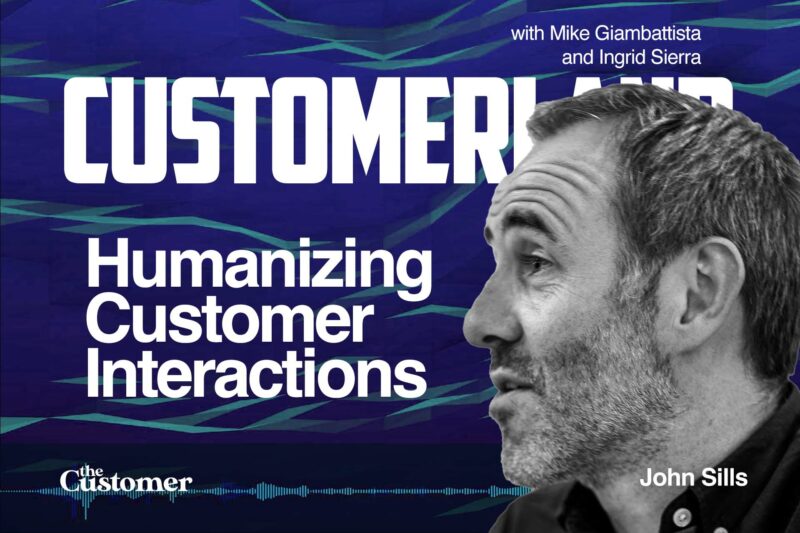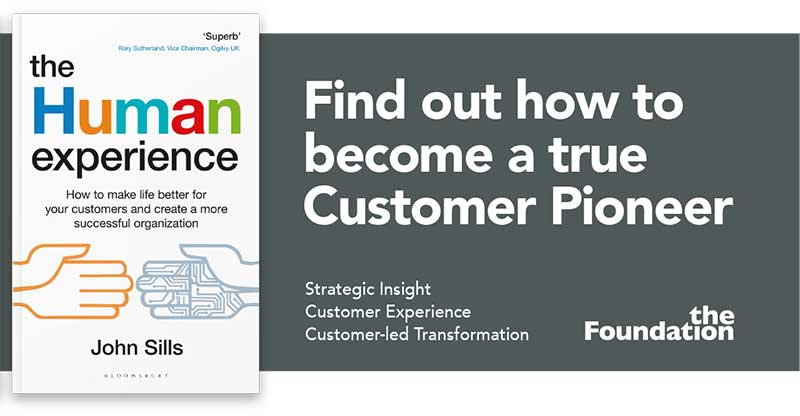Have you ever pondered how a seemingly insignificant experience can completely transform your perspective? That’s the journey we embark on today with John Sills, a customer experience consultant who has seen it all. John shares his rich career journey with us, discussing everything from customer-led success to the importance of customer immersion and engagement.
Imagine walking into a shop in Islington, London. This isn’t just any shop – it’s John’s family’s shop. His mantra, “make your casual custom permanent,” still echoes through these walls, carrying stories of past customers and their experiences. While we dig into the current state of customer experience, John prompts us to think about its future. We ponder on the role of AI in enhancing customer interactions and the risk of losing sight of our customers in this rapidly evolving, product-led era.
We also have a frank conversation about the importance of empowering employees to create excellent customer experiences. Using the story of a friend’s unpleasant burger joint experience, John paints a vivid picture of how failing to empower employees can drastically impact customer experience. This episode of Customerland will challenge you to reflect on your own experiences as both a customer and a provider. It will prompt you to think about how you can evolve to better meet your customers’ needs, all while preserving the human touch that makes experiences memorable. Join us and let’s redefine customer experience together.
Read the Full Transcript Below
John Sills
Thanks, really, I’m really looking forward to the conversation. Yeah, I’ll start with The Foundation. So we’re an independent consultancy based in Kings Cross, work around the world. Broadly, we exist to help create customer-led success. Our version of that is we call creating customer pioneers trying to help organizations that really want to trail blade on behalf of customers, and I suppose the reason we do it is because lots of organizations say they want to do it.
It’s very easy to say but it’s very hard to do. And it’s hard to do because organizations like people will naturally see the world from the inside out, which is closer to our own culture, beliefs in businesses. You’re closer to your own colleagues than you are to your colleagues and processes and regulations than you are to your customers. And even if you think you’re very close to your customers, you’re often not as close as you think you are. So, yeah, we work on customer strategy, customer experience, cultural work, organization of all shapes and sizes, and
I’ve been here eight years before that. I was at HSBC, so I looked after customer experience globally there, launched our first mobile app, which is a whole other story we might talk about later on, but started out damping checks and before that was on a market stall in Essex in England selling haberdashery to mainly older ladies who wanted to buy things for nothing. But yeah, that’s who I am.
Mike Giambattista
So a perfectly linear path to your current position.
John Sills
Yeah, I think when I was 14 on the market stall, I thought, yeah, I know exactly where I’m going to end up here.
I think it’s one of those careers where I’ve almost my career is essentially based on me doing things I always said I was never going to do. So I never thought I’d work in a bank. I never thought I’d work in head office because it looked gray and boring. I never thought I’d work globally because they were so detached from everything else They hated consultants. So it’s never going to be a consultant. They were all coming with backpacks, big PowerPoint presentations with triangles, gave me answers to questions. I didn’t have ended up being a consultant. So yeah, my career is one of absolutely mistaken luck, but somehow it all ties together in making things better for customers, I think.
Mike Giambattista
Well, this will be really interesting to talk to you next year and find out what other things you don’t do and where you end up.
John Sills
No, Mike, I really don’t want to be a millionaire. That’s what I really do. Let’s just put it out there.
Mike Giambattista
That would be terrible.
John Sill does not want to be a millionaire. So the Human Experience first. You win on the title how to make life better for customers and create more successful organization. In our role here, we talk to a lot of CX people CX technology providers, customer experience professionals within brands trying to work out all that, consultants and everybody in between. So we get I get the privilege of hearing all these diverse viewpoints on all the problems involved in executing good customer experiences. There’s no universality, no common out, very little, I should say, in terms of what the key problems are. So, as somebody who was brave enough to write a book about it and come out with a point of view that is actually quite solid, I want to know what you think Is there? this may be a fair question, but I’ll just ask it anyway. Is there any kind of a silver bullet, golden ticket to creating great human experiences.
John Sills
Yeah, I mean, like you say, it’s not really a fair question, but I think in because in a way my temptation is to say there is. You know if I, if I’m being very theoretical about this, i think there is a silver bullet. That’s very easy to do. But I know that when I overlay my reality of working with organizations for so many years, how hard it is to do it. I think for the people that haven’t read the book, essentially the premise is that over the last 20 years we’ve had all this amazing technology that’s come into our what in and to our lives and organizations to use to help make customer experiences better. You know, and we can all now do more things in more ways more quickly than ever before.
But I was actually, i was on, i was actually on a steam train with my son about five years ago and we were a beautiful old steam train big oak, the big leather seats you could fit back into oak panel table, you could bridge your food out on a person coming down the middle of the aisle and having a home baked food And he said to me Oh daddy, is this what it’s like when you get the train into London every day? And I kind of had to laugh. So I thought, no, this is, this is nothing like it. This is kind of glamorous, and it was that that got me thinking. With all this new technology we’ve had, you know what really pro, what real progress looks like, is that you make things better, you make things more efficient, but you keep the level of quality at least the same. And for all this new technology we’ve had, it feels like we’ve really really focused on the functional experience and improving the functional experience, but we’ve lost sight of that emotional, human experience, and so it’s a long way around to answer your question.
But I think the silver bullet is that be more human, if in doubt, be human. We all spend all of our lives learning how to be a human and how to socially interact with other people, how to be empathetic. Like you know, mike, if you and I were sat in a pub now and you gave me some bad news, i know how to respond to that bad news. But somehow, when we, when we speak to organizations, that just gets shut down because people are hitting behind their processes. So in some respects, the silver bullet is quite simple It’s to roll back from all of this stuff we’ve put in the way of being human and just be human, whether that’s a real human, or build humanity into your product. But it’s much easier to say that than it is to do it as organizations, because we’re so ingrained now in the way that we work.
Mike Giambattista
Well, I know you get paid lots of money to help organizations figure out those very equations. It reminds me of an organization here in the States. It’s a, it’s a nonprofit, i can’t remember the name of it, but their mantra is the answer to every question is empathy, which I think is brilliant. It’s essentially saying what you’re saying in another set of words. Working that out institutionally across big organizations is a whole nother thing. But you know, without getting too deep into the weeds of what you really get paid for, but maybe on a level that we can talk about here, you know what are some of the ways that that an organization can start, I’ll just say, re-humanizing themselves for the sake of their customer relationships.
John Sills
Yeah, I think so. I think the first, the first way, is to really reconnect with what matters to your customers. And so in the book I talk about these three myths, and one of them is the myth of customer feedback. And the myth here is that we’ve never had more customer data coming into organizations than we have right now. You know, we’re deluged, organizations are deluged with information, and that means, as customers, we’re all living in this kind of epidemic of feedback service. You know, like you, kind of any experience without being asked your opinion on it. And the problem with this, and the reason it’s a myth, is that this feedback, this deluge of feedback coming in, convinces leaders that they’re close to really what matters to customers. But they’re not. They’re only close to customers opinions of their business, and that the very subtle were very significant difference.
Now what’s happened is leaders are taking all of this data comes in and it’s often presented on PDFs and PowerPoints, and they look at averages and they take that as what matters to their customers. They take that as the things they need to focus on, and what they’ve stopped doing as a result of that is going out and spending real time with real people, going to visit customers in their houses, going shopping with customers, going to work on the front line, being on the end of the phone, speaking to customers directly, not when it’s about a complaint or when something’s gone wrong really immersing in your customers lives. And this is partly driven by the detachment we’ve seen between state leadership and executive pay and most customers.
So the lifestyle is very different. You know, we had a project a few years ago here in the UK and one of the senior managers in a bank just couldn’t understand how someone wasn’t able to save up 30,000 pounds for a mortgage. Just couldn’t understand it until we got him to go and meet a few people who were real people in real places, and then he very quickly understood.
So for me, the very first thing that organizations have to do is really reconnect with what matters to their customers, and for us that’s a thing called immersion. You know that is taking yourself out of your business, getting really, really stuck into real life, surrounding yourself by people that can help remind you of what really matters, getting up to the thick end of the wedge, as we call it. Then work out how you can be most useful to those people. That’ll be the number one thing I’d recommend leaders in organizations do. And frankly, if you’re not doing that, what else do you do with your time? that’s more important.
Mike Giambattista
Well, good point Are there? I would imagine that that different organizations require different methods of achieving that. You know, immersion you can’t just kind of overlay a process on every single organization because there are cultural probably significant cultural differences you’re dealing with there and willingness. So what’s the starting point? You basically just you know I know that you wouldn’t use a PowerPoint, but you know, you know you’re if the first part of the conversation is reconnecting with what’s important to your customers are just understanding and listening to them, what methods would you recommend to an enterprise level organization?
John Sills
Yeah, probably three things I’d recommend in order. The first is to use all of the information and resources you’ve already got available. You know so I talked about a lot of the data coming in, but you know, when you’re a leader of an organization you’ve got all your front 19 right there that speaking to your customers every day. The job number one is speak to your colleagues. Speak to your colleagues that are speaking to customers, get first-hand information and what’s really going on. That can include call listening, you know. That can include spending half a day a week, just even an hour a week, frankly, just lifting just some random calls that have come in to your contact center, looking at a selection of emails that have come in. You know, just picking a few to look at. That’s kind of job one to use that resource. Number two is then try and do something online, because that’s much easier to do, much more flexible to do.
We have a thing called the Immersion Academy, you know, where you get a group of customers for two weeks and you get them just to upload video diaries. You get them to kind of set them a little task tell us what’s on your worry list, get them to do reactions. You know the inflation users come out today. What do you think about that? The skies have gone dark over New York. What do you think about that? How does this worry? How does it affect your life? Just so you’re getting this regular source through and then make time in the leadership team one hour a week. They sit through and look at some of these videos to see what we’ve heard.
The third level is to make time to go and do this in person. Actually, the new or newish now CEO of Uber did this recently. Just signed up, signed up to the Uber driver, spent a day driving an Uber One day a month. Now she goes out and drives an Uber around And that’s pretty much all she needs one day a month to learn what it’s like to be both an Uber driver and learn what it’s like to be an Uber customer, just under that kind of under that guide of doing it for real. So there’s different levels and you can do it using the data you’ve got. You can do it online, you can do it in person, you can be creative in the ways you want to do it, but if you’ve got the willingness to do it, there’s a lot of different ways that you can just engage in customers.
And my Nan so she’s no longer with us. But in 1961, she joined the London telephone exchange And on the first day that she joined she got sent a letter by the CEO of the London telephone exchange welcoming her to the team. And it was all about customers early and it said something along the lines of remember that you are a customer every single day. When you buy a drink, when you go to the cafe, when you get on the bus. You know what the difference is between service giving grudgingly and services given cheerfully. We want you to give us cheerfully and always remember what it’s like to be a customer. And that’s the other thing that people we’re talking about leaders in any business, our customers all the time, every single day of organizations. They just need to remember what that’s like and apply it into their own organization. Too often a barrier is put between the two, but it’s the same thing.
Ingrid Sierra
And I imagine you also need sometimes to scratch quite a lot with customers, right, because as customers where we got so used to some very bad experiences, it’s I imagine the feedback would only be like a 10% improvement of something that can be massively improved because we got into that habit that it’s so difficult.
John Sills
Yeah, yeah, I think that’s right. I mean, I think actually to another way of looking at your question as well, Mike, is to is to make sure you’re really clear and really prioritizing on the things you actually want to go and find out. Yeah, you know, it’s so easy just another sometimes a slight critic of NPS as a result of this but it’s so easy to kind of put in a generic survey system. It gives you generic answers and measures you against the generic experience And then, to your point in grid, you’ll get a certain number of customers come back and they’ve got a bit of survey fatigue. So the average sits between somewhere between seven and eight. That’s very different to go and you know what our experience. These are the three things we really want to focus on.
So, we’re going to prioritize customer immersion, our customer survey, on those three things particularly. That’s all we’re going to focus on. So the three things we want to know about. I’m really deep diving into those and then you can get much more creative with your customers as the questions you ask and how you really understand it, as opposed to this kind of average of a generic experience Right taking the mean.
Mike Giambattista
I’m intrigued by the fact that you said it was your mom’s company Back in 61.
John Sills
My nan, my nan’s company, Yeah. My grandma Yeah.
Mike Giambattista
So those were the crow-magnon years of customer experience. And yet that’s a pretty progressive thought really. I mean we’re in conversations all the time with companies who are trying to say the same things to their employees with a degree of authenticity, to make it believable And change their cultures. so that was way ahead of the curve.
John Sills
Well, I think I would agree with it in a slightly different shape. I think customer experience is a discipline has come around a lot more recently, and so there’s now a lot more thought in organizations about customer experience being a thing. I think you could argue, though, that customer experience has only had to become a thing because organizations have lost sight of customers are the things that matter.
And actually, another family reference I found out recently, literally a few weeks ago one of my Grandad’s cousin something like that used to own a shop about 50 meters from where I’m currently sat in King’s Cross in the office here. I found out he owned a shop in Islington in London, and I knew this because I found a book, which was a 1923 guide to shops in Islington, and page four there’s an advert for his shop FS Seals. And at the bottom it’s got his mantra And it is our aim. It said our aim is to make your casual custom permanent. Make your casual custom permanent.
And I thought, well, that’s so brilliant, it’s such a simple aim, but it’s in a world where people realize that it’s only customers that make you money. Products don’t make you money, it’s customers deciding to buy your products that make you money. And in the product-led world I think we’ve got into in the past 20, 30 years, we’ve lost sight of the customers, and that’s why I think customer experience now has become a discipline And now we kind of have to fight in organizations to get the message heard, because we’ve lost sight of that original thought that of course it’s the customer that matters. So it’s kind of my part of family history I’m 10 years here as well But I think it. I think that we’ve lost something that means we’ve had to come back around to it.
Mike Giambattista
Yeah, I think I’d agree. Two thoughts just occurred to me. One is that that’s our reason for being as well. I mean we’re, we’re called the customer for a reason. I mean, it’s all about making those connections and making them enriched and worthwhile. But two, so customer experience is in your DNA. You’re hardwired for this job, apparently. So, regardless of the fact that you didn’t want to do this, apparently your DNA has something different to say.
John Sills
So hopefully, it says that you’re going to be a millionaire next year.
Mike Giambattista
Oh wait, we don’t want that.
John Sills
Yeah, yeah, it’s annoying when you think you’ve got free will over your life. It turns out it turns out.
Ingrid Sierra
Yeah – “I’m a customer experience.”
John Sills
Yeah, 50 meters away, my relatives were 100 years ago.
Sponsor Announcement
I want to take a quick break from the conversation to tell you about one of our sponsors. What could you achieve if you knew what your customers expected ahead of time? What if you could know what customers expect by category and by brand, 12 to 18 months ahead of traditional brand tracking methods? And what if you could know exactly where to adjust and where to spend in order to drive the most benefit every time, a customer expectation audit allows you to identify areas that require strategic reinforcement, as well as pinpoint which values will contribute most to an emotional bond with your brand and optimize accordingly.
Customerland has partnered with Brand Keys, the world’s oldest loyalty focused consumer research firm, to bring real world customer expectation audits to brands, brand managers and to CX. Practitioners everywhere Want to know where your brand stands and exactly what to do about it. Go to expectationaudit.com and download a sample audit today.
Mike Giambattista
It seems odd in the context of this great rich topic to talk about something as inhuman as AI, but I think it would be, and maybe this takes us way off topic and down a dog leg and a rabbit hole we don’t need to be in. But I just came back from a series of meetings with a series of companies that are developing AI based interfaces that would enable I’m just going to call it empathetic responses and guidance at scale. It’s pretty cool. I mean it’s really cool and very sophisticated processes that are all geared towards helping customers feel like they’re being heard and then helped along the way in whatever their quest is, which is all pretty cool. In the context of this conversation, though, i’m looking forward to the next iteration of those developments that are proactive, that will help companies to be more human proactively, rather than reacting to problems that humans probably created and then getting machines to try and help us fix.
John Sills
Yeah, I think it’s a fascinating area. I’ve been asked the question a few times recently and it’s incredibly hard one to answer, because the technology we’ve got now seems so different from three months ago, seems so different from six months ago, even though it’s been around. But suddenly it hits that tipping point, doesn’t it? as a consumer acceptance, it’s very hard to predict where it will be in five years.
There are a couple of rocks to stand on, though. I’m very clear when I talk about the book and the title even experience that I’m really talking about humanity rather than humans, that humanity can be delivered through machines, through digital experience. It doesn’t have to always be a human. I think the benefits that AI and some of the tools are going to have will be exponential in terms of helping people get stuff done, helping people make better decisions, but also helping colleagues give better answers to customers. It’s actually that third area I think I’m most interested in, because I’ve still got this belief, and I think one of the rocks to stand on is it sounds quite reductive to say, but I think people will always want to shout at a person. People will always want to express some emotion at a person, particularly if something’s gone wrong.
You’ll probably know what I mean. It’s a deal with a company and there’s a problem, and it could be a company’s done saying, well, it could just be, there’s a problem you need help with. You get that script in your head, don’t you? You get that 20, 30-second script in your head when you’re phoning them up or you’re waiting on the web chat. This is the thing I need to say. I need you to hear me and I need to express to you this is the problem. I’ve got. The reason you’re doing that is because you need someone to sit and listen and you need someone to respond and say I hear you. I’m really sorry about that. That sounds really difficult. I’m going to help you resolve that. But I understand what’s gone wrong. As soon as they say that you’ve relaxed, you, calmed down, you think, okay, someone’s heard me, someone’s taken on board what I’ve thought.
Now I don’t think people will accept that from an unhuman. I don’t think people will accept typing that to a known AI or typing that to a known chatbot. In fact, i know they don’t because we have these virtual chatbots now and people go I want to speak to a human. I want to speak to a human. I think that’s why, for me, the more interesting part is how these AI tools are going to help colleagues deliver a bit of customer experience, because I think customers will want that person to say that thing to, will want that person to empathize and acknowledge it, and then they might use all the same AI tools that might have got the same answer for the customer if they just done it themselves. But I think there’s going to still need in many cases to be that acknowledgement and recognition. But I do think the tools that I’m going to say are making will be really good.
The only other thing I’d say on that is I’d be really interested what organizations do in terms of content. There’s been so much on content marketing recently I’ll say recently, past 15 years maybe more And I think some organizations are seeing AI as a holy grail that can help self-generate their content and get rid of copyright. The problem in doing that is it completely commoditizes the organization. Then you start thinking, well, why would I go into that organization for the content anyway, when I can just go and get the information myself? So I think organizations might end up shooting themselves in the foot there by taking away what’s unique or special about that particular brand? Yeah, that’s my other thought on that, i think at the moment. What do you think?
Mike Giambattista
I’ve experimented with some of the generative AI programs. Ingrid, as it turns out, is a whiz at this stuff. Had no idea, but my experiments with the technology have returned information on the content topic that is factual, it is informative, but it is incredibly dry. It’s like reading the equivalent of a sweater. It’s just there’s no flavor. It’s just. What am I doing here? Yeah, yeah, and I’m sure that’ll improve, but the human element will always be there, and I think there’s a raging debate, and content creators and copywriters in particular, about like are we all about to lose our jobs? And I don’t think the answer is yes. I strongly believe that if you’re adept enough at using these tools, you can make your output even bigger and better.
Ingrid Sierra
And I agree with you, Mike. I think the issue is we went from like the human does everything to we’re going to outsource everything to those machines where actually the optimal is that in between, whereas a human you have to put a lot of effort in, as you would when you brief creative agency right And like that. Prompt writing needs to be like, very felt through, based on your strategy, what you want, what you need, the channels and all of that, and then you get an output that is a very good draft, but the machine will never know what you want. So I think we’ve been taking a shortcut and now we are moving back to actually working alongside the tools to actually get what we need, and that’s where probably the smart collaboration is going to happen.
John Sills
Yeah, I think that’s really interesting. I think there’d be a separation between design and delivery as well. Yeah, I think a lot of AI tools could absolutely help deliver fantastic customer experiences, but I think there’s still going to be humans there to design the experience in the first place, we would have got the opportunities to understand what’s really mattering to customers designing what’s needed, then using those AI tools.
Funnily enough, I’ll use Evernote and have a lot of notes on there, the kind of note keeping system And the other day it flagged up and it said we’ve got our new AI cleanup tool. Would you like to use it? And it will help sort your notes a bit better. So I clicked yes and waited for about two minutes And then it finished and all it did was change all my spellings to American. All the use got taken out of color and behavior.
Mike Giambattista
It ruined everything.
John Sills
Everything. That was all it did. Okay, that’s one thing to watch out for.
Mike Giambattista
That’s hilarious. I was really intrigued. I read a handful of your recent articles, but one in particular about your experience with HonestBurger, and I was waiting for the resolution after reading all of the kind of thought prompts about what has changed for you. I’ll put this into my words and you’ll do a better job of explaining it, but essentially, to paraphrase badly, your experience changed when the people delivering it changed, which is a really, really, really important concept for people who are trying to execute high quality CX at scale. How do you mitigate that? How do you manage for that? Anyway, i’ll let you elaborate on that, but I thought it was a great point.
John Sills
Yeah, thank you. It was a fascinating experience actually. So, yeah, we’ve got an HonestBurger that I can see it from here, right obviously, where we are, so it’s a regular lunch hall for it. In fact, if you hit the fire alarm in our office, HonestBurger is our meeting place So we have a lot of fire drills. But you know, being there for years and got to know the team, they got to the manager there and it was a brilliant experience. The music was fantastic, they had really cool photos all the way around off the team being happy, loads of plants, loads of nature around you.
And I’ve got a slightly odd order. I like to order the vegan burger, but I really like bacon. So I say, can I get the vegan burger with bacon? And they were fine with that And they just went with that Like it was completely normal. And yeah, so I wrote an article about how much I love, how much I love Donner’s burgers. And then, yeah, about a month later, the manager came over and he went I’m leaving And she was going to be going elsewhere And actually loads of her team were going with her. So we’re quite upset about that, but we’re still at goodbyes and a special lunch.
And then, yeah, went in a couple of weeks later for the first time and it all changed, like the music was different, because I didn’t realise it was their playlist not an honest, but it was a playlist. All the photos had come down because Liz, the manager, had taken the photos and put them up. All the plants had gone because Liz had bought the plants and put them all in And I put in my normal order and they took it. And then 20 minutes later they came back up and they said sorry, the chef’s just want to check. Did you really mean real bacon? on that?
I was like, yeah, Ii felt slightly, but yeah, you were talking about, because the point was that there was kind of two points with these stories. I think One is, firstly, HonestBurger deserves a whole load of credit, because the original article I was writing was about empowerment and about freedom and about how they empower their teams to create great experiences, and that’s really, really important, particularly in hospitality.
But the second part of it was absolutely that how much that experience changed And where is, i think, that balance of kind of consistency, this thing in the book I called Structured Flexibility, what is the HonestBurger experience on which your team can then build and create their own experience. How much do you want to control versus how much freedom do you want to give? Now I should say it’s not that the new team were giving a bad experience. The food was still great, it was still on time, they were still very pleasant and welcoming. It was just different from before. And I’m sure in time I mean we go in there enough they’ll get used to it, they’ll do the burger right. Maybe I won’t like the music as much, but that’s okay. You can’t always go to a place where you’ve got the music, but I’m sure in time I mean.
Funnily enough, the last time I went in there they started doing things for kids. If you’re going there with kids now, they’ll give you a little mat that they can draw on with crayons. That was never there in the old team with the old team, and actually that’s good for me because I’ve got two kids, so that will develop in time. But I think that’s the interesting question. It’s how do you manage those handovers? Where do you want consistency and where don’t you? But, as you say, a real recognition from leaders who run organizations where people play such a major role that your people are the experience. Your experience lives and dies with those people When you’re.
My friend, who I worked with, went to an airport the other day and he got to the check-in desk a minute after the check-in desk closed and he thought that was okay because the flight was delayed by two and a half hours, but the check-in desk still closed at the same time And the guy said to him yeah, I’m sorry, we’re closed. And then my partner pleaded and pleaded and pleaded with him. No, no, he’s closed, he walks off. The guy just walks off. So my friend goes to complain and that person rolls the right and goes. He always does that. It’s fine, we’ll get it reopened for you. He goes right down. They get him. They get that guy to come back and check my friend’s bags in. He doesn’t say anything about it, he doesn’t act. They’re like yeah, he’s always doing this.
So your people just live and die by that experience, and that is why I see so many customer experience strategies fail. Is it a great on paper that no one looks at the ability of the people No one looks at? are we giving our people the tools to help them deliver the experience? They give them the motivation, they tell them this is what we wanted to deliver, but they don’t give them the ability to actually do it. It’s so crucial if you’re going to create an experience and have consistency within that.














